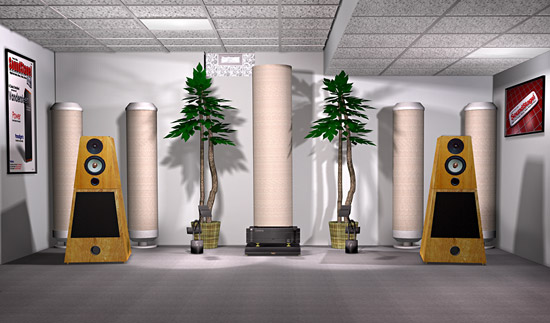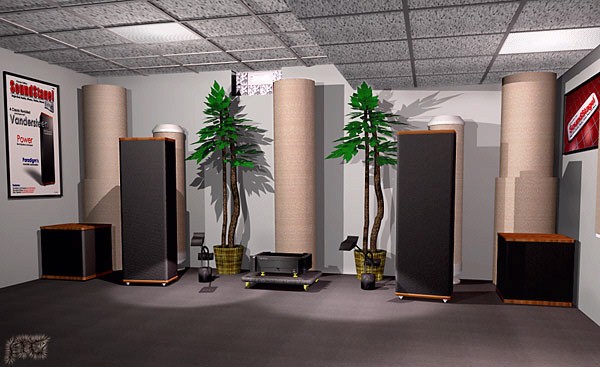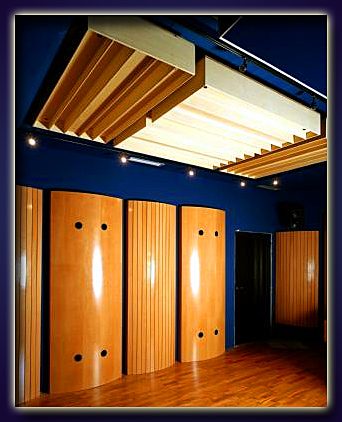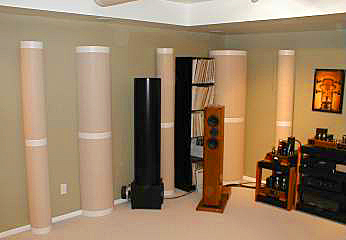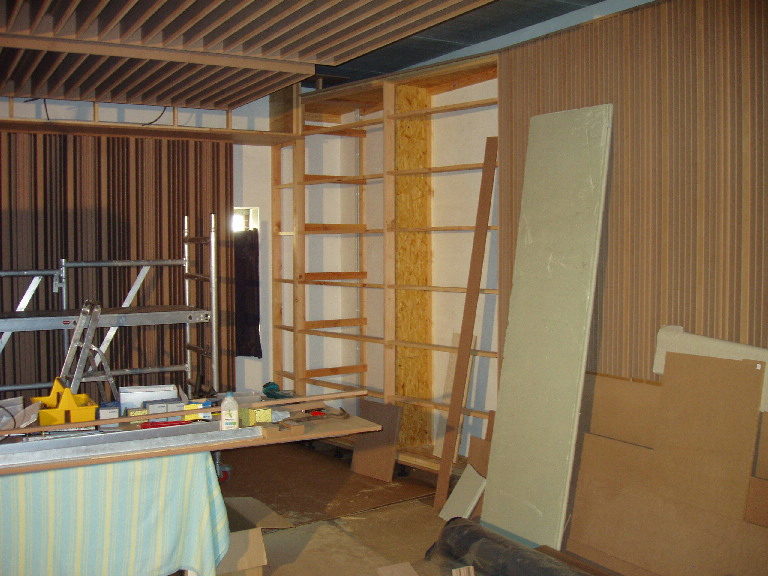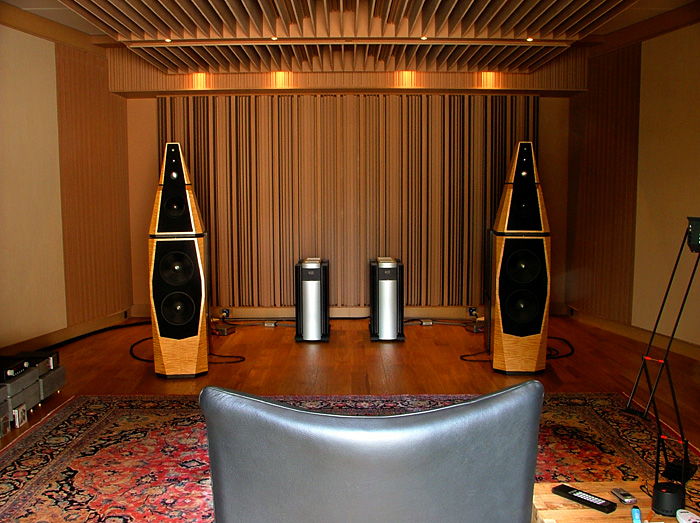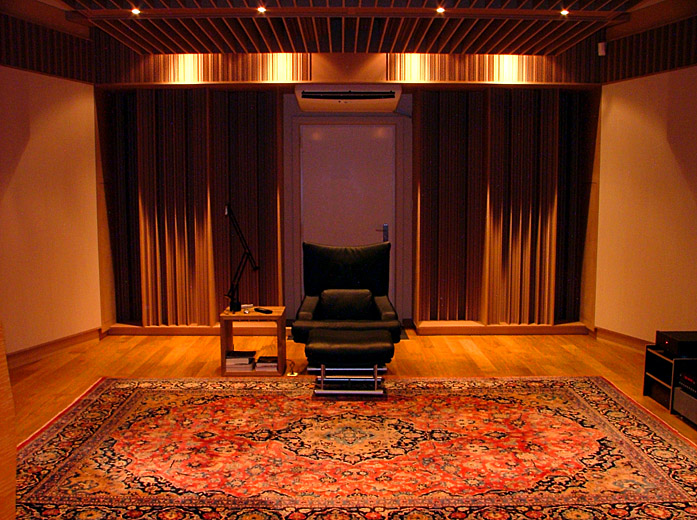Acoustic products take out ( or control) this
bouncing sound, allowing us to hear the unmeasurable,
low-level sound that our ears are designed to use in
orienting and judging distance. Acoustician Peter D'Antonio,
of RPG (Reflection Phase Gratings), says,"the
music you hear in any room is a distorted version of
reality. If you have a performance facility, the room
has to be neutral." A
neutral room, he goes on, "delivers
all the salient spatial cues, and frequency response
information contained in the recording."
Or more succinctly, "what
the room needs to do is not be there."
I've talked about acoustic
problems with John Gibson of EAR Professional Audio/
Video, in Arizona. He says, "I've
designed a lot of control rooms using the SRD program
[Studio Reference Disc, put out by Prosonus] supplied
by ASC. We sweep a room - make the ASC recording -
work out a drawing of the room - and ASC specs out
what is required. We do systems design and equipment
sales, mainly for broadcast and music recording
control rooms and studios. I've done many rooms with
ASC, generally for between two and eight thousand [dollars].
Loosely designed rooms, not too crazy, resulting in a
very workable and usable room. We use them in ground-up
situations, and also going in and fixing things. We've
fixed some really awful things."
Gibson has also done room treatments from the ground
up.
"I did one room for a
company in Maine. This was a ground-up facility where
the room was designed with ASC in mind. Before the
ASC products arrived, the guy got the room up and
running and did some light cosmetic things. Then he
brought in a group of percussionists from Berkeley,
along with some noted artists from Africa, to record
a collection of ethnic material. He had almost
tracked the entire album when he took delivery of the
ASC stuff. Just for the fun of it, we did a few more
tracks, with wood blocks and all. [The difference]
was so dramatic that they pulled everybody back and
did the entire work over again - because of the
difference in the percussion, the airiness and the
transparency, the linearity of the decays, and
everything." Gibson
can work with ASC but primarily he has "to
work with the room. You never know exactly what you
face," he says. "I
don't care who the designer is, I don't care what the
budget is. Until you get in there and sweep it and
find out what is going on, you don't know what a room
really needs."
Both Art Noxon and designer
Chris Kline, of ASC (Acoustic Sciences Corporation),
are frequently seen at major audio shows. Kline
brings and installs the truck loads of ASC products
that control sound in demonstration showrooms. The
major focus of acoustician Art Noxon's company is
designing and building products to solve acoustic
problems.
Within the art of recording, the studio is a
professional machine. ASC has an unusual degree of
passion for providing an acoustic environment, and
offers the same professionalism and care that they
provide in developing a recording studio for any
consumer who asks for their help in creating a home-listening
environment. Although some articles have been written
on Tube Traps and room treatments, I am not aware of
an all-out discussion of acoustic room design using
Tube Traps for the creation of a home "listening
studio" (with apologies to Clark Johnsen, of The
Listening Studio, in Boston). In past articles, ASC
products have been used to correct specific "room
problems." Dan Sweeney in
Issue 83/84 of The Absolute Sound discusses Tube
Traps, and other types of "room treatments."
Most consumers are familiar with standard ASC
products - half rounds, quarter rounds, full rounds,
in diameters of 9,11, 16, and 20 inches. These are
available in customizable lengths and customizable
colors (four standard colors, 60 additional colors at
additional cost)1.
Recently ASC has developed a stylish line of room
treatments, giving them Italian names such as Mobilio
and Bastone. These treatments are functionally
equivalent to the tried-and-true Tube Traps.
For lower cost but with most of the Tube Trap
effectiveness, ASC has devised Tower Traps. Tower
Traps are six feet high by ten inches in diameter (Tower
Slim) or five feet high by 15 inches in diameter (Tower
Stout). Tower Traps have distinctive pedestals and
caps. Other consumer products from ASC include Shadow
Casters (floor-standing panels that look like Dayton-Wright
electrostatic speakers or Quads, containing four
small concealed Tube Traps for absorption and
reflection), Sound Flags (triangular, corner-loaded,
edge-mounted wall panels with 12 inch and 14 inch
sides, for diffusion and absorption), Wall Panels (absorptive
wall panels) and Wave Panels (directional sound
absorbers, designed for side walls).
ASC provides complimentary consulting when working
with a consumer on a home listening room. For
extensive design work, for construction of listening
rooms or studios involving collaboration with an
architect, they charge a fee. Art Noxon designed my
listening room from the early concept and blueprint
stage. The room uses standard Tube Traps: full round
20-inch diameter units (two floor-to-ceiling), full
round 16-inch units (three floor-to-ceiling), half
round 20-inch (two floor-to-ceiling), half round 16-inch
(eight floor-to-ceiling), and half round 11inch (two
floor-to-ceiling).
